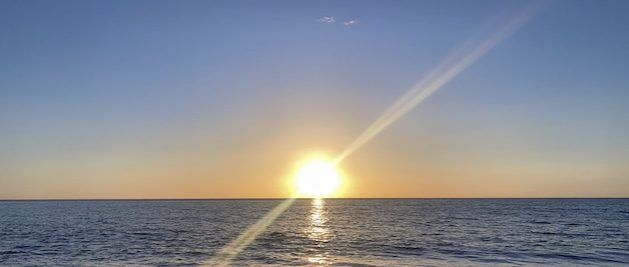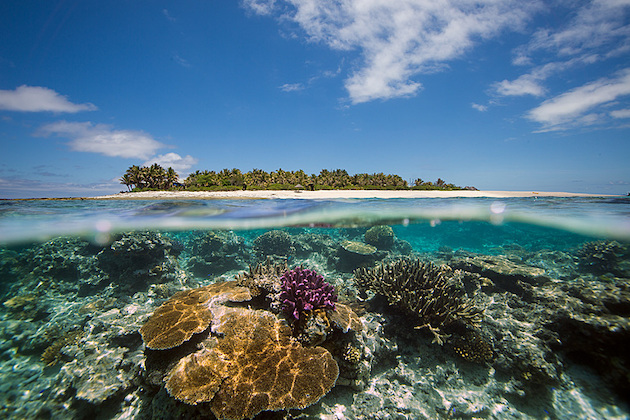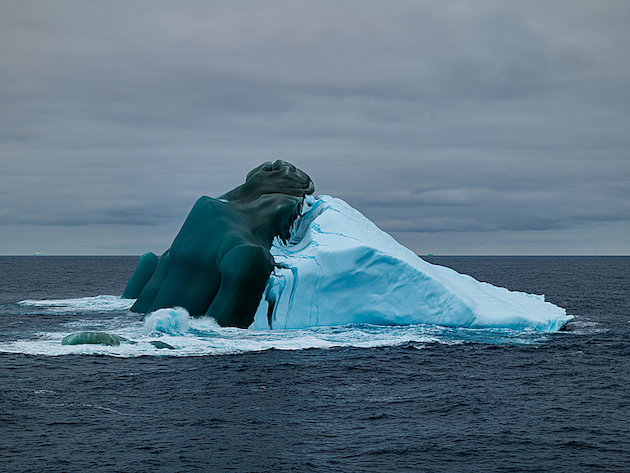We Need to Talk About Deep Blue Carbon

NEW YORK, Jun 08 (IPS) - The focus of carbon capture and storage has long been on coastal ecosystems like mangroves and seagrasses. If the world wants to meet its looming climate targets, then it’s time to head to the high seas — the home of deep blue carbon.Almost half of the world’s population lives in coastal zones. For islands in the Pacific and Caribbean islands such as Dominica, where up to 90 percent of the population lives on the coast, the ocean is fundamental to lives and livelihoods. From fisheries to tourism and shipping, this essential body which covers over 70 percent of the planet, is a lifeline.
But the ocean’s life-saving potential extends much further. The ocean regulates our climate and is critical to mitigating climate change. Researchers have long lamented that major international agreements have failed to adequately recognize the resource that produces half of the earth’s oxygen and whose power includes absorbing 90 percent of excess heat from greenhouse gas emissions.
And while its ability to capture and store carbon has been receiving increased attention as the world commits to keeping global warming below 1.5C, researchers say that coverage of that ability has concentrated on coastal ecosystems like mangroves, seagrass, and salt marshes. This is known as coastal blue carbon.
Protecting and conserving coastal blue carbon ecosystems is very important because of the many co-benefits they provide to biodiversity, water quality, and coastal erosion, and they store substantial amounts of legacy carbon in the sediments below.
Researchers welcome the exposure to topics on ocean solutions to climate change but say the conversation – along with data, investment, and public education – must extend much further than coastal blue carbon. Scientists at Dalhousie University have been driving collaboration, funding, and state-of-the-art research into the earth’s largest carbon sink – located in the high seas.
“It’s easy to imagine the ocean as what we can see standing on the edge of the shore as we look out, or to think about fisheries or seaweed that washes up on the beach – our economic and recreation spaces,” says Mike Smit, a professor in the Faculty of Management and the Deputy Scientific Director of the university’s Ocean Frontier Institute (OFI).
“Beyond that, what you might call the deep ocean, is less studied. It’s harder to get to, it’s not obviously within any national jurisdiction, and it’s expensive. The Institute is really interested in this part of the ocean. How carbon gets from the surface, and from coastal regions, to deep, long-term storage is an essential process that we need to better understand. We know that this deep storage is over 90 percent of the total carbon stored in the ocean, so the deep ocean is critical to the work that the ocean is doing to protect us from a rapidly changing climate.”
OFI’s Chief Executive Officer, Dr Anya Waite, says the phrase ‘deep blue carbon’ needs to be a household one – and soon. She says the omission of earth’s largest repository of carbon from climate solutions has resulted in the issue becoming “really urgent.”
“If the ocean starts to release the carbon that it’s stored for millennia, it will swamp anything we do on land. It’s absolutely critical that we get to this as soon as possible because, in a way, it’s been left behind.”
Researchers at the Institute have been studying deep blue carbon and bringing researchers together to spur ocean carbon research, interest, investment, and policy.
Through the Transforming Climate Action research program, the Institute is putting the ocean at the forefront of efforts to combat climate change.
“The ocean needs to be in much better focus overall. We are so used to thinking of the ocean as a victim of sorts. There is ocean acidification, biodiversity loss, and pollution, but in fact, the ocean is the main climate actor. It’s time to change that narrative, to understand that the ocean is doing critically important work for us, and we need to understand that work better in order to maintain the function that the ocean provides,” says Waite.

Most Important, Yet Least Understood
The OFI is harnessing its ocean and marine ecosystems research to find strategic, safe, and sustainable means of slowing climate change, but time is not on the world’s side to achieve the “deep, rapid and sustained greenhouse gas emissions reductions” that the latest Synthesis Report of Intergovernmental Panel on Climate Change states is needed to limit warming to 1.5C.
“We know that the ocean is changing, and how it absorbs carbon might change,” says Smit. “There are just too many open questions, too high uncertainty, and too little understanding of what will enhance natural ocean processes and what will impair their abilities to continue to work.”
According to Waite, the ocean’s storage capacity makes it a better place to remove carbon from the atmosphere than land options. In fact, it pulls out more carbon dioxide from the atmosphere than all the earth’s rainforests combined. She concedes, however, that the ocean is more complex physically, making carbon capture and ensuring the durability of sinks more difficult.
“We really need to understand the full scope of the ocean’s carbon-absorbing function and bring that into conversation with policymakers, nations, the finance community, and insurance. There are all sorts of impacts when the heat and carbon budget of the ocean are not well observed. Then we don’t have a good prediction system for cyclones, heat waves, and other important phenomena that insurance companies, governments, and the military all need to understand to keep us safe. There are really strong societal reasons for us to do this work.”
The Economics
The OFI’s innovation and research are meant to inform policy and industry. The commercial side of deep blue carbon will be critical to converting ground-breaking research into in-use technology among climate mitigation companies.
Eric Siegel is the Institute’s Chief Innovation Officer. With a background in oceanography, he has spent the last 20 years at the interface of ocean science, technical innovation, and global business.
“We are trying to work more with industry to bring some of the innovations that our researchers are developing to support innovation in companies, but also trying to bring some of those companies into the research realm to help support our work at the Ocean Frontier Institute,” he told IPS.
“For example, carbon removal companies will need to monetize carbon credits as they will have to sequester the carbon. That takes innovation and investment. It’s a great example of companies that do well and generates revenue by doing good, which is mitigating climate. It’s also sort of a reverse of how, over the last couple of decades, companies have donated charitably because they have generally been successful in extractive technologies or non-environmentally friendly technologies. It’s a nice change from the old model.”
Siegel says presently, there just aren’t enough blue carbon credits that can be monetized.
“There are almost zero validated and durable carbon credits that are being created and are able to be sold now. Many people want to buy them, so there is a huge marketplace, but because the technology is so new and there are some policy, monitoring, reporting, and verification limits in place, there are not enough of them.”
Some companies have started buying advanced market credits – investing now in the few blue carbon credit projects available globally for returns in the next five to 20 years.
“I think that this is our decade to do the science, do the technical innovation, and set up the marketplaces so that at the end of this decade, we will be ready – all the companies will be ready to start actively safely removing carbon and therefore generating carbon credits to make a difference and to sell them into the market.”
The pressing need for solutions to the climate crisis means that work has to be carried out simultaneously at every link in the deep blue carbon chain.
“We don’t have the luxury of saying, okay, we have the science right now; let’s work on the technology. Okay, the technology is right; let’s work on the marketplace. The marketplace is right; now, let’s work on the investment. Okay, all that’s ready; let’s work on the policy. We have to do them all at the same time – safely and responsibly – but starting now. And that’s how we are trying to position Ocean Frontier Institute – different people leading on different initiatives to make it happen in parallel.”

Global Collaboration – and the Future
The Ocean Frontier Institute is working closely with the Global Ocean Observing System. With Waite as Co-Chair, the system underscores that oceans are continuous. No one country understands or controls the ocean. It is based on the premise that collaboration between nations, researchers, and intergovernmental organizations is key to maximizing the ocean’s role in fighting climate change.
“Every nation that observes is welcome to join this network, and we then deliver recommendations to nation-states and the United Nations,” says Waite.
“The technical systems that observe the ocean are becoming fragile because nations have other things to put their money into. So, we need to get nations to step in and start to boost the level of the observing system to the point where we can understand ocean dynamics properly. This is in real contrast, for example, to our weather observation systems that are very sustained and have a mandate from the World Meteorological Organization that they must be sustained to a certain level.”
For OFI’s Deputy Director, data sharing will be critical to the collaboration’s success.
“The data that we collect from these observations can’t stop at the desks of scientists. We have to get them out of the lab and into the world so that people have some understanding of what is happening out there. It’s critically important, it’s also really cool, and we need to understand it better,” says Mike Smit.
The Institute’s Chief Innovation Officer wants the world to know that deep blue carbon is positioned for take-offs.
According to Siegel, “We need to start realizing that the ocean and the deep blue carbon is actually the big, big opportunity here.”
And as for residents of the Pacific Islands intrinsically linked to the ocean by proximity, tradition, or industry, Waite says their voices are needed for this urgent talk on deep blue carbon.
“Pacific island nations are uniquely vulnerable to climate change. Their economic zone, extending up from their land, is a critical resource that they can use to absorb carbon to maintain their biodiversity. Pacific island nations have a special role to play in this conversation that’s quite different from those who live on big continental nations.”
Deep blue carbon might not be a household term just yet, but the world needs to talk about it. Dalhousie University, through its Ocean Frontier Institute’s research and partnerships, is ensuring that conversation is heard across the globe.
IPS UN Bureau Report
Follow @IPSNewsUNBureau
Follow IPS News UN Bureau on Instagram
© Inter Press Service (2023) — All Rights Reserved. Original source: Inter Press Service
 Global Issues
Global Issues